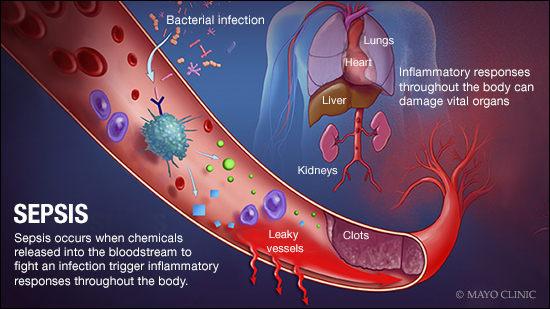You may have heard alarming news stories about sepsis on television or via the internet. Frightening reports tell of individuals coming close to death after experiencing seemingly minor infections. For example, the little girl who ended up in the hospital after trying on shoes in her bare feet or the man whose limbs were amputated after a dentist nicked his gums. Does the possibility of sepsis lurk within every cut, scrape, or surgical procedure? Read on to learn what sepsis is and how it most commonly strikes.
What Is Sepsis?
Sepsis is a serious complication of an infection. It refers to the emergency situation in which the body launches an overwhelming and excessive response to an infection. When there is an infection present in the body, it triggers an appropriate immune system response against the invading organism. However if the infection burden is too high, the body’s immune response may not be sufficient and this could lead to sepsis and without quick treatment, sepsis can lead to multiple organ failure and death.

Bacteria, viruses, or fungi can all cause infections and any of such infections may lead to a case of sepsis. However, bacteria are the most common culprits. Common illnesses such as Pneumonia, a urinary tract infection, or appendicitis can cause sepsis in some individuals. Others may experience a severe case of sepsis when a surgical procedure introduces bacteria into their bloodstream. sepsis most frequently affects sickly or immuno-compromised patients following major illness, chemotherapy, radiotherapy or surgery.
While sepsis can strike anyone, regardless of age, there are certain populations at greater risk of this condition. The elderly, infants under the age of one, and persons with immune disorders are at the greatest risk of suffering from sepsis. patients who are hospitalized, have diabetes or cirrhosis of the liver, or have extensive wounds or burns may also be susceptible. Furthermore, procedures or devices that involve foreign objects in your body can introduce bacteria and cause sepsis. These can include surgeries, breathing tubes, catheters, and implanted devices such as pacemakers or IUDs.
Sepsis can be challenging to distinguish from other maladies due to the generalized symptoms.
Sepsis should be suspected in babies and children If the child or baby:
● looks mottled, bluish or pale
● is very lethargic or difficult to wake
● feels abnormally cold to touch
● is breathing very fast
● has a rash that does not fade when you press it
● has a fit or convulsion
● a temperature over 38C in babies under 3 months
● a temperature over 39C in babies aged 3 to 6 months
● any high temperature in a child who cannot be encouraged to show interest in anything
For adults, In the early stages, symptoms may include mental confusion, fever, chills, rapid breathing, and an increased heart rate. Many disorders and illnesses can present with these same symptoms. Therefore, linking these symptoms with a recent infection, cut, surgery, or illness might give the doctor a high incidence of suspicion for sepsis.
Tests to diagnose sepsis may include blood tests to check for increased white blood cells and a culture to check for any micro organisms such as bacteria which may be responsible for the infection. A doctor may perform other tests to determine the source of infection that has triggered sepsis. These may include urine analysis, chest x-rays, or CT scans because urinary tract infections and chest infections are rather common infection sources.
Treatment for sepsis includes providing antibiotics to cure the original infection while treating any damage sepsis has caused to organs. Treatment varies depending on the type of infection, the severity of the sepsis, and the damage to body tissues and organs. Broad spectrum antibiotics are usually started intravenously when sepsis is suspected and then these antibiotics may be changed depending on the results of the blood cultures.
Many patients recover from sepsis and go on to live normal lives. However, patients who have severe sepsis which isn’t detected and treated promptly may suffer additional complications. In some cases, sepsis can develop into a severe drop in blood pressure known as septic shock. Acute respiratory distress syndrome is another complication of sepsis which can lead to permanent lung damage. Patients who suffer from kidney damage may continue to require dialysis. If blood clots form and deprive tissues of oxygen, amputation may be required. Still other patients may be more susceptible to future infections following sepsis.
Certain factors which have been found to contribute to the increasing cases of sepsis include a surge in antibiotic resistance, and an increase in organ transplants. Also, many people are living longer, leading to an increasing number of elderly or chronically ill individuals.
In order to prevent infections which may then progress to sepsis, it is important to wash your hands frequently and keep wounds clean and bandaged as they heal. Remember that any wound that isn’t kept clean can become infected, including body piercings. Finally, seek immediate medical attention if you have signs of sepsis such as fast heart rate, fever or chills, confusion, difficulty breathing, pain, and clammy skin, or an infection that is not improving.






